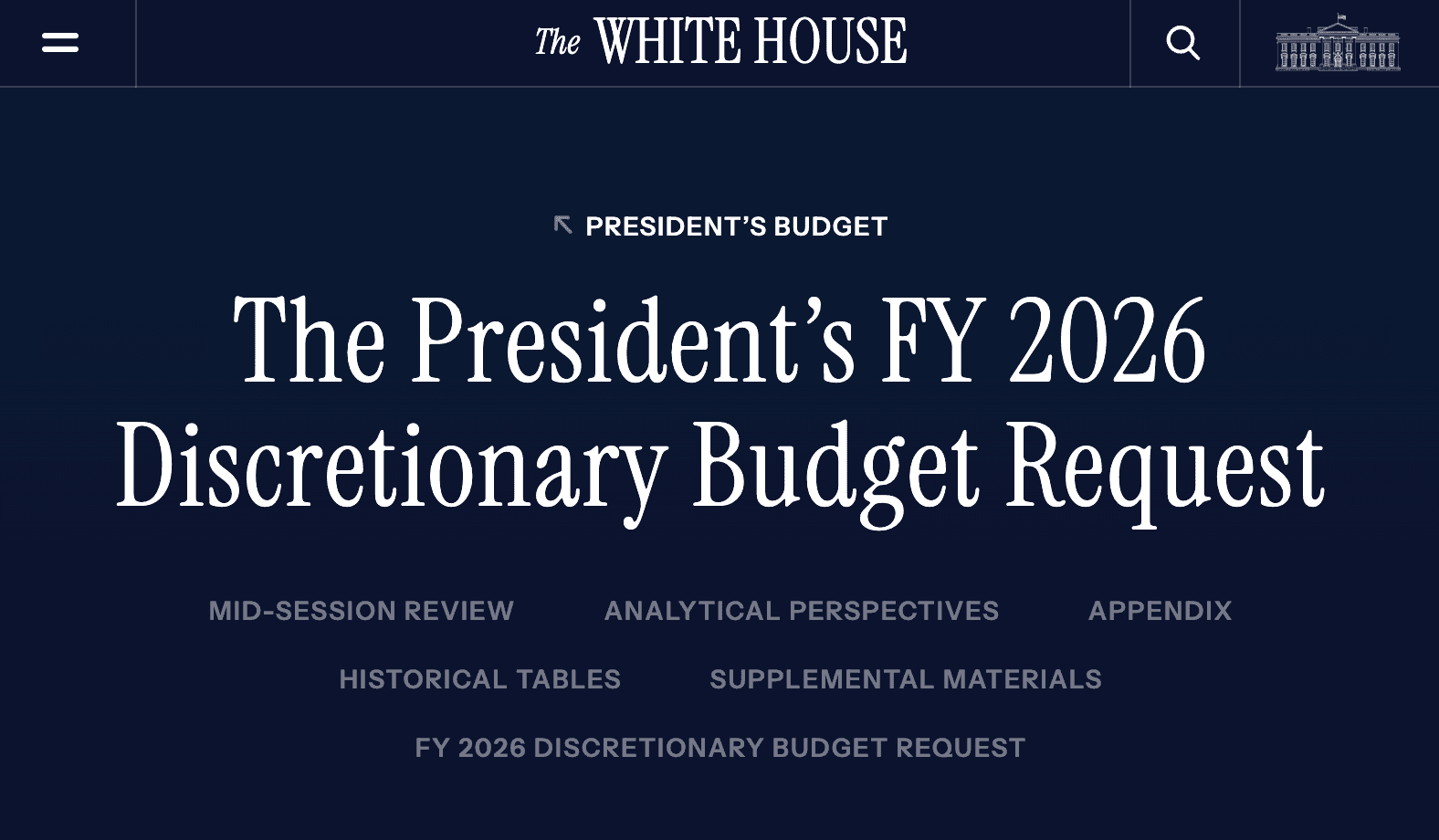
News
By Smart Growth America, May 5, 2025
Last Friday, May 2nd, President Trump released his “skinny budget,” a document that sets out his vision for the federal government by providing a rough outline of the more detailed budget request he will release later this year. While the president has attacked core federal programs before, this limited budget request proposed a deep and devastating range of spending cuts that would slash vital housing, transportation, and community development programs and devastate communities across the country.
Presidential budget proposals provide a venue for a president and their administration to lay out their idealized vision for the federal government. While it is in practice a vision that is often dismissed or quickly reshaped by Congress, it reflects the values and goals of an administration. With an emboldened executive in the White House who has been keen to use impoundment and executive orders to enforce his own budgetary vision when it conflicts with that of Congress, the budget also provides advocates some insight into programs and agencies that may be at risk of further reductions or attacks by the administration or other actors working to carry out his agenda.
In the midst of a severe housing affordability and access crisis, President Trump proposed a series of cuts that would leave communities across the country, and particularly small towns and rural communities, struggling to meet even the most basic of their housing and infrastructure needs. From deep cuts to the Community Development Block Grants (CDBG), the HOME Investment Partnerships Programs, and housing assistance programs, the cuts are best characterized as anti-community—intentionally designed to eliminate, defund, or decrease the capacity of federal government agencies that directly support the local financial and social institutions that support our country.
Local governments are often limited in the amount of property taxes they can extract from their populations due to zoning and, in some cases, shrinking populations. This means many communities will be left with massive gaps in essential funding if federal support suddenly disappears. So, instead of having the flexibility to explore innovative, smart growth strategies to improve their community, cities and towns will be pushed to such a level of financial precarity that steep cuts down to basic survival-level operations will be the only option. Together, these budget changes would financially devastate small towns and lead to the defunding of local services and local government programs, increase homelessness across the country, and abandon already resource-constrained American communities.
The president’s budget proposes to gut programs that provide direct assistance to local governments that meet local needs and other programs that will directly impact/further constrain smart growth:
- The elimination of CDBG, the biggest and most flexible funding source for small and rural communities to install and maintain infrastructure, as well as help catalyze and support private sector development.
- The elimination of HOME formula grants would halt the development and preservation of affordable housing through the program, leaving communities without critical, flexible resources they use to help low-income families find homes.
- Significant reductions to the USDA Rural Development Programs ($721 million), which provide grants, infrastructure loans, rural business loans, rural housing vouchers, and other services to rural communities.
- The elimination of the PRO-Housing program (Pathways to Removing Obstacles to Housing), which sought to provide resources to communities to help them identify and address barriers to affordable housing production, including zoning and land use policies.
It proposes gutting programs that provide housing or cost-saving services to individuals:
- Devastating cuts to federal rental assistance programs that serve families, veterans, seniors, and residents in communities of all sizes, to the tune of 26 billion dollars. The proposed cuts continue Trump’s targeting of HUD services that keep people housed, and while the budget proposal claims that removing rental assistance will spur states and the private sector to fill the gap, the much more likely outcome is a rise in homelessness.
- The elimination of the Low Income Home Energy Assistance Program (LIHEAP) that supports households facing energy burden, including older adults; this support is especially critical at a time of ever-rising housing costs due to climate change which is causing more extreme heat events, and worsening natural disasters which disproportionately hurts lower income and historically marginalized communities.
It proposes gutting programs that fund local entities that provide services in their communities:
- The elimination of the Community Services Block Grant, which provides funding directly to community action agencies to provide critical services locally, including by providing help accessing nutrition, utility, education, employment, and transportation programs.
- Over $290 million in cuts to the CDFI Fund, which provides funding to community development financial institutions that, in turn, provide affordable credit, capital, and financial services for the communities they operate in, with a particular focus on under-resourced rural and urban areas.
- Elimination of the Neighborhood Reinvestment Corporation, also known as Neighborworks, a congressionally chartered nonpartisan nonprofit that provides direct funding and technical assistance to community organizations pursuing affordable housing and community development projects.
- The elimination of the Essential Air Service program (EAS), which helps small and rural communities maintain air service and connectivity; if EAS is abolished without a substantial investment in rail or an alternative mode of connectivity, rural communities will be further isolated economically and socially.
Beyond these cuts, the budget reaches deep into government to undermine smaller programs at a variety of agencies that support communities from unique angles, including:
- Uncertainty around transportation funding due to a conspicuous lack of detail on funding requests—there are only requests for seven budget accounts (despite there being dozens of accounts administered by USDOT), and there are no requests for the Federal Transit Administration.
- A $22.5 billion cut in Infrastructure Investment and Jobs Act funding, a 34 percent decrease from FY25, without fully specifying which programs will be affected. In light of previous statements and actions, passenger rail, transit, electric vehicle infrastructure, and other multimodal transportation grants could be under threat.
- Targeting EPA’s environmental justice work, which has focused on helping support community-led solutions to environmental concerns in a variety of ways.
- Cuts to data programs at NOAA that informed land use and development planning to keep future housing out of harm’s way from increasingly frequent and intense storms.
- Over $160 million in cuts to the Small Business Administration’s Entrepreneurial Development programs, which provide assistance to the small local businesses that make up the backbone of Main Street America.
Implicit in the smart growth movement is a deep care for the well-being and vibrancy of communities, from the youngest residents to those who have lived in a neighborhood their entire lives to future residents. If these cuts become law, communities would be unable to meet many basic needs, let alone invest in the well-connected, affordable places to live that help all community members lead prosperous, healthy lives. Instead, the budget would advance sprawling single-family detached housing patterns, further straining municipalities’ fiscal abilities to provide services. From pushing for the elimination of the Community Development Block Grant program to gutting funding for community development financial institutions, the president’s budget seems to reject the basic idea that the federal government should support communities in their efforts to become and remain vibrant, livable places for all residents.
While the threat to the funding itself is dangerous, Congress will shape the final budget, and many members, including those from Trump’s own party, have already rejected components of the budget out of hand. While this is a positive sign, the budget’s full-scale ideological turn against federal support for community growth is a serious threat to federal programs in both the short and long term.
Seeking fiscal responsibility does not necessitate abandoning constituents and communities. Smart growth advocates should reach out to their members of Congress and push them to reject this budget proposal and continue to invest in programs that make all communities more healthy, prosperous, and resilient. Congress can and should exercise its constitutional power of the purse and adopt a budget that supports smart growth strategies and meets the needs of Americans and their communities.
Related News

© 2025 Smart Growth America. All rights reserved
Site By3Lane Marketing






















